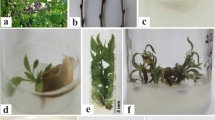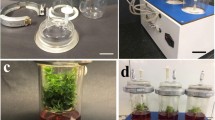Abstract
The traditional methods of propagation of hazelnuts are time-consuming and not satisfactory at the commercial level. Therefore, the goal of current investigation was to optimize micropropagation of three commercial cultivars of hazelnut including ‘Gercheh’, ‘Gerdooyi’ and ‘Pashmineh’. In the present experiment, the effects of four levels of Benzylaminopurine (BAP; 0.50, 1.00, 2.00 and 4.00 mg L−1) with kinetin (0.25 mg L−1) and without kinetin on the shoot induction and proliferation were investigated. In addition, the effects of six treatments (NRM3 [control], NRM3/2, 0.50 mg L−1 IBA + 0.50 mg L−1 NAA, 0.50 mg L−1 IBA, 1.00 mg L−1 IBA + 1.00 mg L−1 NAA, and 0.50 mg L−1 NAA) on rooting of the studied cultivars were studied. Results showed that the best treatment for shoot proliferation for ‘Gercheh’ was 0.25 mg L−1 kinetin + 0.50 mg L−1 BAP as well as the best treatment for rooting of this cultivar was 1.00 mg L−1 IBA + 1.00 mg L−1 NAA. In ‘Gerdooyi’, the optimum treatment for shoot proliferation was 0.25 mg L−1 kinetin + 4.00 mg L−1 BAP, while the best treatment for its rooting was 0.50 mg L−1 IBA + 0.50 mg L−1 NAA. In ‘Pashmineh’, the best treatment for shoot proliferation was 0.00 mg L−1 kinetin + 0.50 mg L−1 BAP. In addition, the best treatment for rooting of this cultivar was NRM3/2. The results presented herein could be used for micropropagation of hazelnut.
Zusammenfassung
Die traditionellen Methoden der Vermehrung von Haselnüssen sind zeitaufwändig und auf kommerzieller Ebene nicht zufriedenstellend. Ziel der aktuellen Untersuchung war es daher, die Mikrovermehrung von drei kommerziellen Haselnusssorten zu optimieren. Im vorliegenden Experiment wurden die Auswirkungen von vier Benzylaminopurinkonzentrationen (BAP; 0,50, 1,00, 2,00 und 4,00 mg L−1) mit Kinetin (0,25 mg L−1) und ohne Kinetin auf die Sprossinduktion und -proliferation untersucht; ebenso die Auswirkungen von sechs Behandlungen (NRM3 [Kontrolle], NRM3/2, 0,50 mg L−1 IBA + 0,50 mg L−1 NAA, 0,50 mg L−1 IBA, 1,00 mg L−1 IBA + 1,00 mg L−1 NAA und 0,50 mg L−1 NAA) auf die Wurzelbildung der untersuchten Haselnusssorten. Die Ergebnisse zeigten, dass die beste Behandlung für die Sprossproliferation für die Sorte ‘Gercheh’ 0,25 mg L−1 Kinetin + 0,50 mg L−1 BAP war. Die beste Behandlung für diese Sorte bezüglich der Wurzelbildung war 1,00 mg L−1 IBA + 1,00 mg L−1 NAA. Bei der Sorte ‘Gerdooyi’ war die optimale Behandlung für die Sprossproliferation 0,25 mg L−1 Kinetin + 4,00 mg L−1 BAP, während die beste Behandlung für die Wurzelbildung 0,50 mg L−1 IBA + 0,50 mg L−1 NAA war. In der Sorte ‘Pashmineh’ war 0,00 mg L−1 Kinetin + 0,50 mg L−1 BAP die beste Behandlung für die Sprossproliferation. Die beste Behandlung für die Verwurzelung dieser Sorte war NRM3/2. Die hier präsentierten Ergebnisse könnten für die Mikrovermehrung von Haselnüssen verwendet werden.


Similar content being viewed by others
Change history
06 December 2019
<Emphasis Type="Bold">Erratum to:</Emphasis>
<Emphasis Type="Bold">Gesunde Pflanzen 2019</Emphasis>
<ExternalRef><RefSource>https://doi.org/10.1007/s10343-019-00481-7</RefSource><RefTarget Address="10.1007/s10343-019-00481-7" TargetType="DOI"/></ExternalRef>
Unfortunately the authors have forgotten to add the “Acknowledgments” section to this paper. The section should be as …
References
Aziz A, Rab A, Jan I, Sajid M (2007) Evaluation of hazelnut varieties under the climatic conditions of Kalam. Swat Am Eurafrican J Sustain Agric 1(1):42–44
Bacchetta L, Bernardini C, Di Stefano G, Pelliccia O, Cavicchioni G, Di Bonito R (2005) Molecular characterization by RAPDS and micropropagation of Italian hazelnut cultivars. Acta Hortic 686:99–104
Damiano C, Catenaro E, Giovinazzi J, Frattarelli A, Caboni E (2005) Micropropagation of hazelnut (Corylus avellana L.). Acta Hortic 686:221–226
Diaz-Sala C, Rey M, Rodriguez R (1990) In vitro establishment of cycloclonal chain from nodal segments and apical buds of adult hazel (Corylus avellana L.). Plant Cell Tissue Organ Cult 23:151–157
Driver JA (1987) Nursery handling of propagules. Cell and Tissue Culture in. Forestry 2:320–335
FAOSTAT (2014) At: http://faostat.fao.org/site/339/default.aspx. Accessed 21 Feb 2015
Flinn BS (1986) In vitro control of caulogenesis by growth regulators and media components in embryonic explants of eastern white pine. Canadian J Bot 64:1948–1956
Gao XH, Liu JN, Ling Q (2008) Tissue culture and rapid propagation of hybrid hazelnut (Coryllus heterophylla × C. avellana). Acta Hortic 771:207–211
Gaspar T, Coumans M (1987) Root formation. Cell and Tissue Cul. For, vol 2, pp 202–217
Jones OP, Webster AD (1989) Improved rooting from conventional cuttings taken from micropropagated plants of Pyrus communis rootstocks. J Hort Sci 64:429–434
McCown BH (1988) Adventitious rooting of tissue cultured plants. In: Davis TD, Haissig BE, Sankhla N (Eds.). Adventitious root formation in cuttings, vol 2. Dioscorides, Portland p 289–302.
Mehrotra S, Goel MK, Kukreja AK, Mishra BN (2007) Efficiency of liquid culture systems over conventional micropropagation: A progress towards commercialization. Afr J Biotechnol 6:1484–1492
Messeguer J, Mele E (1987) Clonal propagation of Corylus avellana L. “in vitro,” p. 293–295. Atti del Convegno Internazionale sul Nocciuolo, Avellino, Italy, 22–24 Sept. 1983.
Nas MN, Read PE (2004) Improved rooting and acclimatization of micropropagated hazelnut shoots. HortScience 39:1688–1690
Pérez C, Rodríguez A, Revilla A, Rodríguez R, Sánchez-Tamés R (1987) Filbert plantlet formation through in vitro culture. Acta Hortic 212:505–510
Perez-Bermudez P, Sommer HE (1987) Factors affecting adventitious bud induction in Pinus elliottii (Engelm.) embryos cultured in vitro. Plant Cell, Tissue and Organ Culture 11:25–35
Pythoud F, Buchala AJ (1989) The fate of vitamin D3 and indole butyric acid applied to cuttings of Populus tremula L. during adventitious root formation. Plant Cell Environ 12:489–494
Author information
Authors and Affiliations
Corresponding author
Ethics declarations
Conflict of interest
N. Mardani, A. Khadivi and A. Vatanpour-Azghandi declare that they have no competing interests.
Rights and permissions
About this article
Cite this article
Mardani, N., Khadivi, A. & Vatanpour-Azghandi, A. Micropropagation of Three Commercial Cultivars of Hazelnut (Corylus avellana L.). Gesunde Pflanzen 72, 41–46 (2020). https://doi.org/10.1007/s10343-019-00481-7
Received:
Accepted:
Published:
Issue Date:
DOI: https://doi.org/10.1007/s10343-019-00481-7




